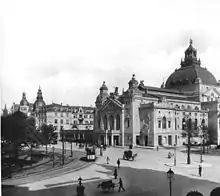Städtische Bühnen Frankfurt
Städtische Bühnen Frankfurt (literally: municipal stages of Frankfurt) is the municipal theatre company of Frankfurt, the largest city of Hesse Germany. The name dates back to 1919. The company is structured today in two organisations, Oper Frankfurt for opera, and Schauspiel Frankfurt for drama (Schauspiel).
 Opern- und Schauspielhaus Frankfurt in 2014 | |
| Location |
|
|---|---|
| Leader |
|
| Website | www |
Building details | |
| General information | |
| Coordinates | 50°06′29″N 8°40′27″E |
| Other information | |
| Seating capacity | |
| Public transit access |
|
The largest venue for both organisations is their common home, the Opern- und Schauspielhaus at the Willy-Brandt-Platz in the centre of Frankfurt. It was opened in 1963 at the location of the former Schauspielhaus. The Bockenheimer Depot is an external stage for both organisations.
History



Opened in 1782, the Comoedienhaus (comedy house) was the first permanent venue of theatre in Frankfurt, for both plays and opera.[2] In 1880, an opera house (Opernhaus) was built. Both sections (Sparten) were organised as the Vereinigte Stadttheater (Common city theatres), headed by general manager (Generalintendant) Emil Claar. In 1902, a Schauspielhaus was opened for plays, designed by Heinrich Seeling in Jugendstil.[3]
From 1919, the name was changed to Städtische Bühnen. Bombing in World War II destroyed the Opernhaus and damaged the Schauspielhaus badly. After the war, performances were held at the hall of the Frankfurt Stock Exchange instead. Based on the ruins of the Schauspielhaus, a new facility was created to provide both plays and operas, and realized in stages completed in 1963.[3][4] The ruin of the Schauspielhaus was restored from 1950 to 1951, as Großes Haus der Städtischen Bühnen. In 1954, planning began for a larger and more modern house, again as a modification of the existing location. Beginning in 1959, per the designs of architectural firm Apel & Beckert, the facade was completely replaced, with some elements of the old house partly retained inside.[3]
The new house was decorated by a large painting commissioned from Marc Chagall in 1959, Commedia dell’Arte.[5] The ceiling of the foyer which is common for play and opera is decorated with a sculpture by Zoltán Kemény, Goldwolken (Golden Clouds).[6] The house was opened in December 1963.[6]
On 12 November 1987, fire damaged the large hall.[7] During restoration, opera was played in the small hall, while plays were performed at the Bockenheimer Depot. The large hall was back in service in 1991.[7]
Organisation
Städtische Bühnen was an organisation with one general manager (Generalintendant) until 1972. The artistic sections were then split to Oper Frankfurt and Schauspiel Frankfurt, served by a common technical stage service.[8] Schauspiel Frankfurt was headed in 1972 by Peter Palitzsch who introduced Mitbestimmung (copartnership),[8] supported by city councillor Hilmar Hoffmann,[9] which became the Frankfurter Modell, a model for other theatres such as Theater Bremen.[10]
In 2004, the organisation was changed to a GmbH of the city of Frankfurt, with the artistic directors as chief executive officers, as of 2019 Bernd Loebe and Anselm Weber.[11]
The Theater am Turm was part of the Städtische Bühnen from 1995 until it was closed in 2004. Ballett Frankfurt was closed, also in 2004. Its director from 1984, William Forsythe, continued his program with The Forsythe Company from April 2005 to 2015.[12]
References
- "Das Haus". Städtische Bühnen Frankfurt am Main (in German). Retrieved 19 December 2022.
- Bartetzko, Dieter (2013). "Man will doch nur spielen. Die unendliche Baugeschichte der Städtischen Bühnen Frankfurt". Städtische Bühnen Frankfurt (in German). Frankfurt. Retrieved 17 April 2019.
- Alexander, Matthias (21 September 2016). "Das wandelbarste Gebäude der Stadt". FAZ (in German). Frankfurt. Retrieved 18 April 2019.
- Schulze, Rainer (12 September 2016). "Warum Oper und Theater in der Innenstadt bleiben müssen". Frankfurter Allgemeine Zeitung (in German). Frankfurt. Retrieved 11 July 2019.
- Crüwell, Konstanze (25 September 2008). "Heiterer Farbkosmos für Theaterflaneure". Frankfurter Allgemeine Zeitung (in German). Frankfurt. Retrieved 11 July 2019.
- Hierholzer, Michael (11 September 2013). "Unter Goldwolken". Frankfurter Allgemeine Zeitung (in German). Frankfurt. Retrieved 11 July 2019.
- Göpfert, Claus-Jürgen (5 April 2016). "Wiederaufbau der Oper nach Großfeuer". Frankfurter Rundschau (in German). Frankfurt. Retrieved 11 July 2019.
- Fischer-Lichte, Erika (2017). Tragedy's Endurance: Performances of Greek Tragedies and Cultural Identity in Germany since 1800. Oxford University Press. pp. 258–259. ISBN 978-0-19-250650-4.
- Brauneck, Manfred (2016). Die Welt als Bühne: Geschichte des europäischen Theaters (in German). Vol. 5. Springer-Verlag. pp. 329–330. ISBN 978-3-47-600029-3.
- "Theater / Kraft nach innen". Der Spiegel (in German). 21 July 1980. Retrieved 16 July 2019.
- "Städtische Bühnen Frankfurt". Städtische Bühnen Frankfurt (in German). Retrieved 9 August 2019.
- Crompton, Sarah (7 March 2015). "Elevated visions: how William Forsythe changed the face of dance". The Guardian. Retrieved 30 June 2019.